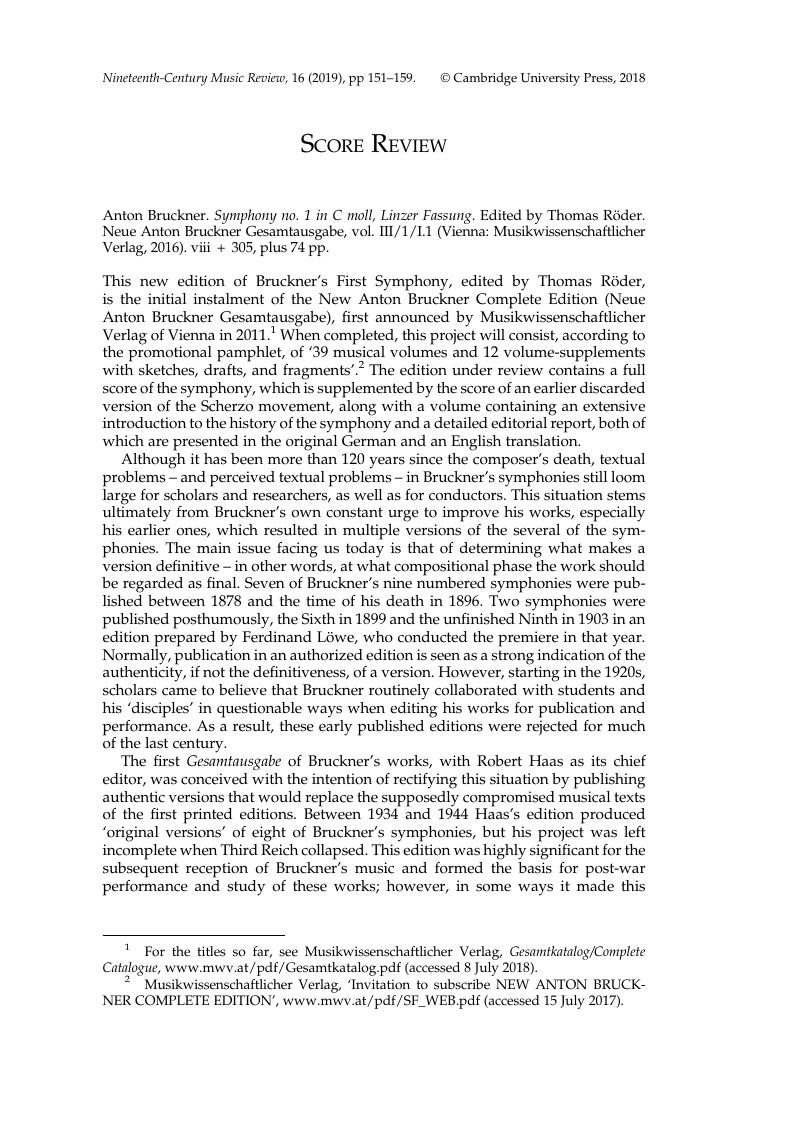No CrossRef data available.
Published online by Cambridge University Press: 06 August 2018

1 For the titles so far, see Musikwissenschaftlicher Verlag, Gesamtkatalog/Complete Catalogue, www.mwv.at/pdf/Gesamtkatalog.pdf (accessed 8 July 2018).
2 Musikwissenschaftlicher Verlag, ‘Invitation to subscribe NEW ANTON BRUCKNER COMPLETE EDITION’, www.mwv.at/pdf/SF_WEB.pdf (accessed 15 July 2017).
3 For example, the musical text of Haas’s edition of the Eighth Symphony combines elements of two distinct versions of the work in a way that does not correspond fully with any of the composer’s manuscript sources.
4 However, editorial reports remained unpublished for some scores published in the second Gesamtausgabe, including ones for the Linz and Vienna versions of the First Symphony.
5 Musikwissenschaftlicher Verlag, ‘Invitation to subscribe’.
6 These names (‘Linz’ and ‘Vienna’) originate from Robert Haas who edited the two versions of the First Symphony for the first Gesamtausgabe. In the first Gesamtausgabe, only the First Symphony was available in two different versions. In the second Gesamtausgabe, a more systematic format of a combination of a Roman and an Arabic numeral was established to indicate different versions of the same symphony (i.e. I/1 and I/2 indicating the two versions of the First Symphony).
7 ‘Editorial Report’, 19 and 26.
8 ‘Editorial Report’, 55. The second copy score preserved the original ‘pre-1877 reading’ in the Finale. The original manuscript score, the first copy score, and the second copy score are available for viewing online at the website of the Austrian National Library in Vienna (www.onb.ac.at). They are: Anton Bruckner, Symphonie No. 1 C moll, Mus.Hs.40400 Mus, http://data.onb.ac.at/rec/AL00227974 (accessed 15 July 2017). Anton Bruckner, Symphonie N 1, Mus.Hs.3190 Mus, http://data.onb.ac.at/rec/AL00228039 (accessed 15 July 2017). Anton Bruckner, Symphonie No I in C moll : für grosses Orchester. Nr. 1 c-Moll, WAB 101, Mus.Hs.3192 Mus, http://data.onb.ac.at/rec/AL0048446 (accessed 15 July 2017).
9 Röder, ‘Editorial Report’, 25.
10 However, there are already a couple of recordings of much the same musical text. Georg Tintner’s recording of the First Symphony, which appeared in 2000, purportedly uses a score of the ‘Unrevised 1866 Linz version’ prepared by William Carragan. The recording’s booklet indicates that Carragan prepared the score from Haas’s critical report. Another recording appeared in 2012 conducted by Gerd Schaller using the same score by Carragan. Anton Bruckner, Symphony No. 1 in C minor (1866): unrevised Linz version, prepared by William Carragan from the critical report of Robert Haas, Royal Scottish National Orchestra conducted by Georg Tintner, Naxos 8.554430, 2000, Compact Disc. Anton Bruckner, Symphony No. 1 in C minor, Version 1866 (Edition Carragan), Philharmonie Festiva conducted by Gerd Schaller, Profile PH12022, 2012, Compact Disc.
11 Röder, ‘Editorial Report’, 22. This seems to be a result of his studies of the periodic phrase structure of Beethoven’s Third and Ninth Symphonies in the summer of 1876. Benjamin Korstvedt, ‘The First Edition of Anton Bruckner’s Fourth Symphony: Authorship, Production and Reception’ (PhD diss., University of Pennsylvania, 1995), 248.
12 In the Scherzo movement, there is no addition or deletion of bars. The only difference is the arpeggio figuration in Violin 1, Violin 2 and Viola in bar 43.
13 Here is a comparison of lengths in bars of the first, second and fourth movements between the new edition and the Haas and Nowak editions: 344:351, 166:167, 405:396.
14 Röder, ‘Editorial Report’, 54.
15 Röder, ‘Editorial Report’, 25.
16 Röder, ‘Editorial Report’, 57.
17 Röder, ‘Editorial Report’, 22.
18 Röder, ‘Editorial Report’, 54.
19 Certainly, though, this is a great improvement over Nowak’s edition, which tacitly includes revisions from the 1870s but declares on its cover: ‘FASSUNG 1866’.
20 Röder, ‘Editorial Report’, 19.
21 Röder, ‘Editorial Report’, 22.
22 Röder, ‘Editorial Report’, 27.
23 The only exception among the last versions of Bruckner’s Symphonies is Adagio of the Eighth Symphony where a solo violin part is effectively employed.
24 In bar 53 all the instruments (one bassoon and two horns) are marked ‘solo’ markings. See, for example, the performance on 7 February 2013 by Paavo Järvi and Frankfurt Radio Symphony Orchestra posted to YouTube; starting at 2:02 at www.youtube.com/watch?v=O8UpiWmlMTs (accessed 20 December 2017).
25 After this section, there is no indication to cancel the ‘Solo’ marking on the cello part in bar 67 in the original manuscript. In the first copy and the second copies, ‘Celli due’ is marked indicating the divided cello parts reverts to one. In the new edition, an editorial marking, [Unisono] is placed.
26 Röder, ‘Editorial Report’, 27. Haas added ‘(Tutti)’ for the other two places (bars 134 and 325) as an editorial marking that is absent in the manuscript sources when the applicable section ends, to ensure that the previous ‘Solo’ markings indeed indicate a single player playing.
27 In fact, since Nowak’s edition was a merely a corrected photo-reprint of Haas’s edition’s, this is the first wholly new layout of the score since 1935!
28 The score of Alfred Orel’s edition of the Ninth Symphony in the first Gesamtausgabe was also entirely printed. Nowak also used the same engraving for his edition. Bruckner, Anton, Anton Bruckner Sämtliche Werke, Band IX: 9. Symphonie D-moll, Studienpartitur, ed. Leopold Nowak (Vienna: Musikwissenschaftlicher Verlag, 1951)Google Scholar.
29 The new edition has 292 pages excluding the old Scherzo, while the Haas and Nowak editions have 120 pages. Bruckner, Anton, Anton Bruckner Sämtliche Werke, Band I/1: I. Symphonie C-moll, Linzer Fassung, Studienpartitur, ed. Leopold Nowak (Vienna: Musikwissenschaftlicher Verlag, 1953)Google Scholar.
30 Orel’s 1934 edition of the Ninth (in the first Gesamtausgabe) is also printed without hiding empty staves, but one page still contains substantial amount of music, thereby minimizing page turns.
31 In 1893, Bruckner signed his will and testament in which bequeathed his autograph manuscripts, including some earlier versions, to the court library for future publication. August Göllerich and Max Auer, Anton Bruckner: Ein Lebens-und Schaffensbild, vol. 4, no.3 (Regensburg: G. Bosse, 1922–36; rpt, 1974), 545.
32 Brosche, Günter, Preface to Anton Bruckner, Anton Bruckner Sämtliche Werke, Band I/2: I. Symphonie C-moll, Wiener Fassung, Studienpartitur, ed. Günter Brosche (Vienna: Musikwissenschaftlicher Verlag, 1980)Google Scholar.